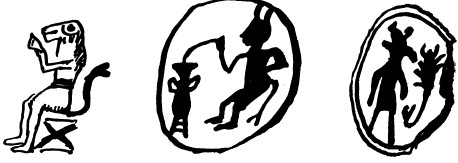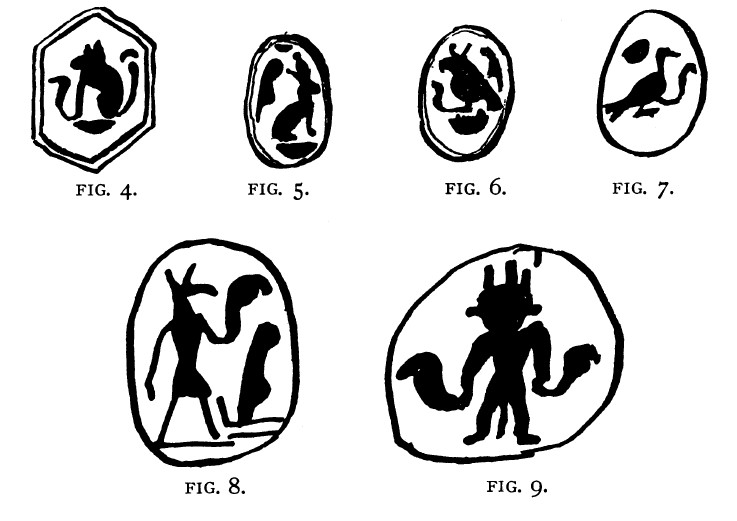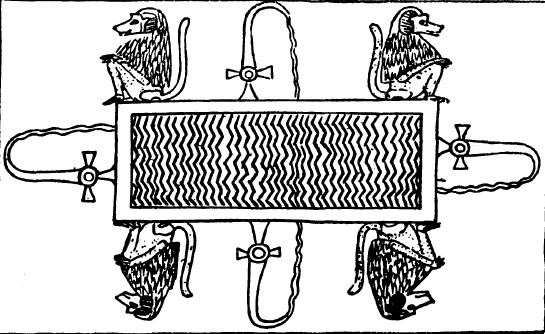The well-known symbols13 of the four Evangelists are taken from the Apocalypse, with the Egyptian order of mention restored: St. Matthew, man-headed; St. Mark, lion-headed; St. Luke, ox-headed; St. John, eagle-headed. Here we have the last echo of the genii of Amenti. The four genii also very frequently appear on coffers, stone sarcophagi, and on wooden painted mummy cases; also on painted wooden stebe of Ptolemaic date. The mummy cases date from about B. C. 1400 to Roman times. On the coffer of queen Ma-ka-ra, of the XVIIIth dynaty, are four remarkable speeches of the genii : Mestha (or Amset) says: “I am Mestha thy son who

THE FOUR GENII CARVED ON AN ANCIENT CROSS, HEMSBY, NORFOLK
loves thee ; Lo ! I have come in peace to make thee receive incense, oil, stuffs, offerings of cakes and herbs, O Osiris, divine wife, Ma-ka-ra,” etc. Hapi says : “I am Hapi thy son who loves thee ; verily I am come in peace to make thy soul come out, so that it may hover about any place it likes, O divine wife,” etc. Duamutef says: “I am Duamutef thy son, who loves thee ; I am come to make thee go out and come into Neter khert; may thy soul not be separated from thy body O Osiris, divine wife,” etc. Qebhsennuf says: “Verily I am come to make thee reach heaven ; to cross the celestial abyss, and mingle with the stars, O divine wife,” etc. On the black basalt sarcophagus of the lady Tent-Hapi, in the Louvre, the four genii appear; Amset brings her ka,1* ego, double; Hapi brings her ab,15 heart; Duamutef brings her &a,16 soul; Qebhsennuf brings her sahu,11 or mummified body. In the tomb of Neb-unnef (XlXth dynasty) Amset offers him his ka ; Hapi offers him his ab ; Duamutef offers him his ba; but Qebhsennuf offers, instead of the sahu, the deceased’s khaibit, or “shadow,” which has been ex plained fancifully as the light in heaven of the soul on earth; compare the pictorial halo of Christian saints. On the sarcophagus of Hor-sa-Isis, son of the lady Ta-du-a (XXth dynasty) in the Biblioth?que Nationale, this speech of Amset is written: “O Osiris, Hor-sa-Isis, creative of voice, blessed one with the great God, Lord of Heaven, over all the gods; (who art) living as a god in Him, I am Amset, I am thy son Horus, who loves thee, I protect thee every day; I have made thy house (tomb) strong. .. .by order of Ptah; I have repulsed thine enemies for thee as I repulsed Apap from Ra. Thoth subdues thine enemies; Anubis makes whole thy maladies, O Osi ris!” On the curious mummy-case of a lady, Mut-shep-n Chonsu, daughter of Auf-kat, in the Louvre, the four genii are represented standing in the folds of a large ser pent, which is spitting out fire at the enemies of Ra, and of the deceased. On the mummy case of the daughter of Dioscoros (Biblioth?que Nationale, second century A. D.) in order to help her resurrection, the four genii are found; also the god Anubis and two groups of Isis suckling the infan
Horus. These groups symbolize the new life promised to the daughter of Dioscoros. Written in gilded uncial letters on her mummy are the words “O daughter of Dioscoros, farewell !” The four genii are conspicuous figures in the Rhind Papyrus, translated by Dr. Birch. The man for whom the papyrus was made, Menkara (born B. C. 68) is laid out as a mummy in the Pool of Chons, surmounted by the sacred eye. Over him are the genii, in abnormal order. Khebsennuf, Hapi, Amset, Duamutef. Of the mummy it is said, Amset rejoices to embalm him; Hapi delights to obliterate his faults; Khebsennuf rejoices he has passed from the place of preparation. In the fourth Plate the four genii adore Osiris and say, “We come to our father (Menkara) when he approaches the underworld. He did no evil in his day…. We declare his goodness before the Lord of the Empyreal region. He listens to our words, the Lord of the West.” The four children of Horus are found on the linen stuccoed disk called “Hypocephalus,” a mystic amulet full of elaborate animal imagery typifying the resurrection. The immense length of time during which belief in the genii endured is very remarkable, and shows the feeling of timidity in the ancient Egyptians, and how much they dreaded the perils which were awaiting them after death. (7) Four Angels at the Four Corners of the Earth. Rev. vii. I. “Four angels standing on the four corners of the earth.” These angels recall to one’s mind the fune rary genii, who, as has been already mentioned, repre sented the cardinal points of the compass. According to one Egyptian version of the creation, the genii posted themselves at the corners of the earth and received the four angles of the firmament (imaged as a ceiling of iron upon which the divine ocean rolled) on the point of their scepters. Therefore they are called in the Book of the
“The pillars of the god Shu.” In Chapter LX the deceased prays that he may have power over the divine beings “who have mighty arms in their shoulders,” i. e., those who uphold the sky, the four genii, or children of Horus. The hieroglyph for storm, tempest, etc., shows the sky falling away from the four scepters, its supports. At the Sed festival, or festival of the Royal Fillet, identified with the uraeus which adorned the king’s forehead, (corona tion festival) four geese, which personified the genii were let fly to the four corners of the horizon; each goose was apostrophized thus: “Go to the north19 (to the south, east, west) and say to the gods of the north (of the south, east, west) that Horus (the king) son of Isis has assumed the great double crown and that the king of the south and north (here his name is given) has taken the double crown (of Egypt).” (8) Tears Wiped Away. Rev. vii. 17. “And God shall wipe away all tears from their eyes.” And Is. xxv. 8. This beautiful expression is paralleled20 in the Hymn to the Nile, the work of the scribe Ennana, which has often been translated, and most recently by M. Guieysse, in the Recueil, 1900. In the sixth stanza of this hymn we read, “Thou driest the tear of every eye,” literally “is drunk the water of eyes all by him (the Nile).” (?) Scorpion Tails. Rev. ix. 10. (The locusts) “had tails like unto scor pions, and there were stings in their tails.” Scorpion or forked tails are rare in ancient art. There is a deity with a forked tail on a broken seal, from Knossos,Crete. Also the god Bes in Dorow and Klaproth’s An tiquit?s Egyptiennes, Plate XIV, No. 721, is figured with a forked tail, and holding a drinking tube inserted in a large amphora. The pre-Mena god Set is represented in hieroglyphs as an animal with a forked tail thus

How important the forked tail was, is shown by being placed separately from the animal’s body. That there was a connection between Set and the scor pion is shown by a rare scarab in the Edinburgh Museum (broken). On the stele of the year 400, found in Tanis, Set wears

DEITY FROM CRETE. BES. SET.
a long pigtail, ending in a fork, which appears to issue from the god’s crown, and two small forks are over his forehead. (10) Lion-headed Horses with Serpent-headed Tails. Rev. ix. 19. “The heads of the horses were as the heads of lions. .. .for their power is in their mouth, and in their tails; for their tails were like unto serpents, and had heads, and with them they do hurt ” Animals with serpent-headed tails, and serpents com ing out of their limbs and bodies are a peculiarity of Egyp tian scarabs, but though more common than examples of scorpion or forked tails, they are not very common. In the Ashmolean Museum, Oxford, there are two scarabs of lions with serpent – headed tails, such as I have not found elsewhere, Figs. 1 and 2. (Fig. 1 seems to be a lioness). Lanzone has figured a lion with serpent issuing from its foot21 and also a horse with a serpent springing from his hoof, Fig. 3. This horse, from the accompanying hieroglyphs we

know to be a symbolic representation of Pharaoh, for the incription runs: “Beautiful lord of the two lands.” This is the common formula used for the king on scarabs. The uraeus serpent is the symbol of the divinity and royalty, which were fused in the Egyptian imagination. Another quadruped found with serpent issuing from its foot the cat, Fig. 4, (Ashmolean). Dorow and Klaproth have also figured a similar one. These cats with uraei are rare. Professor Petrie has figured a cat wearing the double crown of Egypt, Fig. 5; the ostrich feather behind is divine symbol. Of birds, the hawk, representing Horus, wearing the crown of Lower Egypt, Fig. 6 (Queen’s Col lege, Oxford, Collection), and Amen Ra as a goose, Fig.7, (Naucratis, Vol. I) are found with serpents issuing from the foot.Of gods, Set and Bes are distinguished as being de picted with a serpent, or serpents issuing from their body, or from their limbs, or else the serpent is stationed in the field beside, or behind them, see Fig. 8 (Louvre) of Set, and Fig. 9 of Bes (Lanzone). There is also an Etruscan example of a serpent-headed tail on an ancient vase.

Many Crowns
Rev. xix. 12. “And on his head were The Pharaohs wore the two crowns together South Egypt, combined at an early date, and that the kings of any other ancient country than one crown at a time. Like the feathers and the plumes of Osiris, these two crowns, signia of the gods and goddesses, became models of them in fa?ence are to be found Rev. xx. I, 2. “And I saw an angel come down from heaven, having the key of the bottomless pit and a great chain in his hand. And he laid hold on the dragon, that old serpent, which is the devil.”. .. . Sutu is a kind of Egyptian devil or dragon, eater of hearts, from whom the deceased prays to be delivered. In Chapter XVII of the Book of the Dead the deceased prays : “Deliver me from the great god who carrieth away the soul, who eateth hearts, etc. Who then is this? It is Suti.” In Chapter XXVIII deceased again prays: “Let

THE LAKE OF FIRE.
not my heart be given to him (Suti). In Chapter CVIII we read: “Then Sutu is made to flee with a chain upon him of steel.” Sutu is sometimes found fused with the great serpent Apap, and he is represented on the sarcoph agus of Seti I chained, with the scorpion goddess Serq lying over the chain. The exact meaning of the goddess in this position is unknown, as so much else in Egyptian mythology. (13) The Lake of Fire. Rev. xx. 14. “And death and hell were cast into the lake of fire…. And whosoever was not found written in the book of life was cast into the lake of fire.” The Egyptian lake of fire is pictured with four apes seated at its corners, and four signs of fire between them. I have not been able to discover its object. In Chapter CXXVI of the Book of the Dead we find the deceased praying, “Hail ye four apes….do away with my evil deeds and put away my sin… . Oh grant that I may make my way through the underworld, and let me enter into Restau, let me pass through the hidden pylons of Amenti.” The four apes answer, “Come then, for we have done away with thy wickedness, and we have put away thy sin …. Enter therefore into Restau, and pass through the hidden pylons of Amenti.” (14) The Wall of Jasper. Rev. xxi. 10. “That great city, the holy Jerusalem” ; and 18th verse, “And the building of the wall of it was of jasper.” The fields of Aarru, to which the ancient Egyptian thought that the beatified deceased person went after death, had a wall of iron round them. Iron was used as a pre cious metal, being scarce and difficult to work, long before becoming a useful metal. The wall round the Egyptian Elysian Fields was not for strength, but it was made of the then most precious material known, showing the ex treme antiquity of the remote time when this mythology arose. In Chapter CIX of the Book of the Dead, the de ceased says : ” I know the Sekhet Aarru of Ra, the walls of which are of iron.” Again, in the papyrus of Nu, Chapter CXIX, deceased says: “Hail, ye Sekhet Aarru, the walls of which are of iron !” Iron, on account of being magnetic, a mysterious prop erty to the ancients, was also sacred and amuletic in Egypt. In spite of haviflg made these few achaeological re marks, addressed to the intellect, I am thoroughly vinced of the truth of Paracelsus, when he says that “We must read the Bible more with our heart than with brain,” because the heart is greater than the mere brain:
“For knowledge is the swallow on the lake That sees and stirs the surface shadow there But never yet hath dipt into the Abysm‘
but
“Who speaks the things that Love him shows Shall say things deeper than he knows.”





